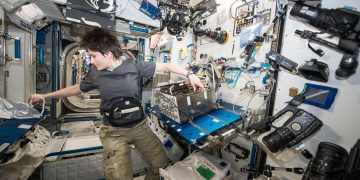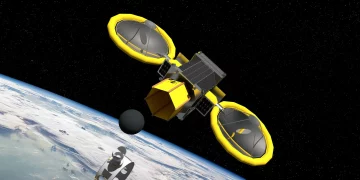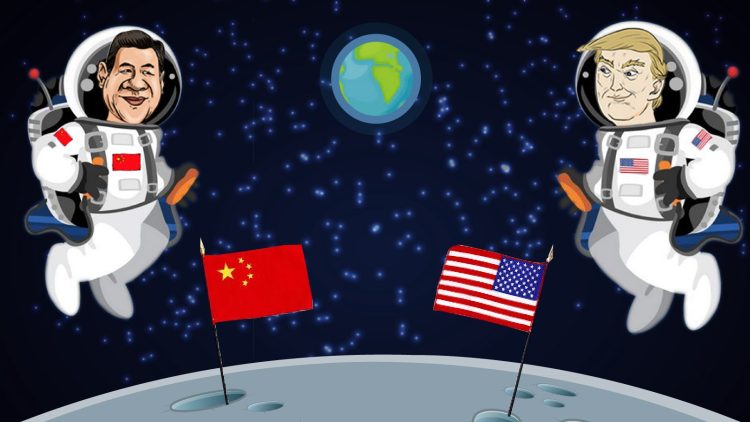Introduction: The New Space Race
The modern space race, which has seen new heights since the dawn of the 21st century, is now largely defined by the U.S.-China rivalry. As the two most influential global powers, the United States and China are both making significant strides in their space programs, often competing for supremacy in areas like lunar exploration, Mars missions, and even deep space exploration. What was once a race primarily between the U.S. and the Soviet Union has now evolved into a more complex geopolitical competition with broader implications for global influence and technological innovation.
However, as both countries advance their space programs at breakneck speeds, the dynamics between them are not exclusively competitive. Increasingly, the space industry has highlighted the potential for international cooperation to address the enormous challenges of deep space exploration. The collaboration between countries with differing political ideologies, histories, and strategic priorities represents a unique shift in the global approach to space exploration.
In this article, we’ll examine how the U.S.-China space race is unfolding, how it impacts international collaboration in space exploration, and how this dual approach of competition and cooperation is likely to reshape the future of deep space exploration.
The U.S.-China Space Race: A New Era of Space Exploration
The U.S.-China space rivalry has intensified in recent years, with both countries investing heavily in advanced space technologies, infrastructure, and ambitious long-term missions. This modern space race is more than just a demonstration of national pride; it has geopolitical, technological, and economic ramifications. Here’s a closer look at the key areas of competition between the two nations.
1. Lunar Exploration: The Return to the Moon
In 2019, China made history with the Chang’e-4 mission, becoming the first nation to land a probe on the far side of the Moon, a remarkable feat that cemented China’s growing space capabilities. The mission marked a significant milestone in China’s lunar exploration program, which is expected to continue with more ambitious plans, including the Chang’e-5 mission to bring lunar samples back to Earth and the construction of a lunar research station by the 2030s.
Meanwhile, the United States has returned to the Moon through NASA’s Artemis program, which aims to land the first woman and the next man on the lunar surface by 2025, and establish a sustainable human presence on the Moon by the end of the decade. The Artemis program, which involves both public-private partnerships and international cooperation, aims to prepare for future missions to Mars. This makes the U.S. Moon missions not only a demonstration of power but a stepping stone to greater ambitions in deep space exploration.
While the U.S. and China’s lunar ambitions remain separate, both countries see the Moon as a critical base for future deep space missions, with the potential for future competition and possibly cooperation.
2. Mars Exploration: A Race to the Red Planet
Mars exploration is another area where the U.S. and China are stepping up their efforts. NASA’s Perseverance rover, which successfully landed on Mars in February 2021, continues to send back valuable data, marking the United States as a leader in Martian exploration. NASA’s plan to send humans to Mars in the 2030s represents one of the ultimate goals of its space program.
China, however, is not far behind. In 2021, China successfully launched its Zhurong rover, becoming the second country to successfully land a rover on Mars. This success has positioned China as a serious player in Martian exploration. Like the U.S., China is also eyeing the potential of human missions to Mars, although their timeline is still less clear compared to the United States.
As both nations race to understand Mars’ geology, climate, and potential for life, the possibility of competing interests in future Martian missions is high. However, both countries have expressed interest in future collaborations in space science, particularly in areas such as space robotics and telecommunication technologies, which could lead to fruitful partnerships in Mars exploration.
3. Deep Space Missions: The Gateway to the Unknown
Beyond Mars and the Moon, the United States and China are both investing in deep space missions that explore the broader cosmos. The U.S. National Aeronautics and Space Administration (NASA) is collaborating on missions like the James Webb Space Telescope (JWST), which aims to peer deep into the universe to explore the formation of galaxies, stars, and planetary systems. The JWST is expected to revolutionize our understanding of the universe, opening the doors to exploring the very origins of life.
On the other hand, China has ambitious plans to explore the outer planets with missions that target Jupiter’s moons and even the edge of the solar system. The China National Space Administration (CNSA) has already launched multiple successful missions to the Moon, and its upcoming plans include sending probes to asteroids and conducting missions to study deep space phenomena.
This emerging competition in deep space exploration will likely push both nations to invest more in advanced technologies like ion propulsion, nuclear thermal propulsion, and advanced robotic explorers. The stakes are high, with the potential to unlock new resources, scientific knowledge, and global influence in the realm of space.
The Role of International Cooperation: Collaboration in Space Exploration
While the U.S. and China are undoubtedly in competition on many fronts, space exploration is a field that inherently demands international cooperation. The complexities and costs of deep space exploration are so vast that no single country can bear the burden alone. In addition, space exploration often transcends geopolitical boundaries, and scientific knowledge is shared for the betterment of humanity.
1. International Partnerships in Space
NASA has long been involved in international cooperation, particularly through its partnerships with the European Space Agency (ESA), the Canadian Space Agency (CSA), and the Japan Aerospace Exploration Agency (JAXA). Programs like the International Space Station (ISS) serve as a prime example of collaboration among nations to foster scientific research and advance space technology.
Even China, which is not a partner on the ISS due to political and diplomatic reasons, has been building its own space station, Tiangong. The Chinese space station is expected to be fully operational by 2022, and it represents a significant achievement in China’s space ambitions. Despite this competition, China has emphasized that international partnerships will be essential to future space endeavors, including its lunar and Mars missions.
One area where international collaboration is increasingly vital is in space sustainability. As more countries and private companies venture into space, managing space debris, preserving orbital environments, and ensuring space security will require global cooperation.
2. The Benefits of Space Diplomacy
Space diplomacy—diplomatic efforts to foster international collaboration in space exploration—has gained increasing importance. Spacefaring nations recognize the value of working together, particularly as they confront shared challenges such as the safe use of space, protecting space assets, and addressing the long-term implications of space exploration.
The Artemis Accords, an international framework led by the United States, aims to establish peaceful principles for the exploration and utilization of space, including the Moon, Mars, and other celestial bodies. Several nations, including Australia, Canada, Japan, and the United Arab Emirates, have signed on to the Accords. The inclusion of China in such global treaties remains uncertain, but the foundation of space diplomacy is already set.
International space agencies have repeatedly stated that deep space exploration is a shared human endeavor and that collaboration will be essential as humanity aims to extend its reach beyond Earth.

The Future of Deep Space Exploration: Competition or Cooperation?
Looking forward, the future of space exploration seems to be one of increasing collaboration, even amid intense competition. The U.S.-China rivalry will likely continue to shape the industry in the coming decades, but the challenges of exploring deep space—such as resource management, technological innovation, and scientific discovery—will require nations to work together.
The competitive aspect will likely drive innovation, while the cooperative aspect will enable long-term, sustainable exploration. The future of space exploration might see both U.S. and Chinese missions operating in parallel, sharing knowledge and technologies where applicable while competing to achieve milestones in space exploration first.
Ultimately, the U.S.-China space race will not only push the boundaries of what is possible in space but will also test the limits of international diplomacy and cooperation. It is likely that deep space exploration in the future will not be defined solely by competition, but by a delicate balance of both collaboration and rivalry.
Conclusion: A New Era for Space Exploration
The intensification of the U.S.-China space race is a defining feature of 21st-century space exploration. As both countries make incredible strides in lunar, Martian, and deep space exploration, the future of space exploration will be shaped by competition, cooperation, and international partnerships. Although rivalry will continue to spur technological innovation, the immense challenges of deep space exploration demand that nations collaborate for the collective good of humanity.
Whether through joint missions, shared scientific data, or global space treaties, the world’s space agencies will have to find new ways to work together. As humanity reaches farther into space, the lessons learned from both competition and cooperation will serve as the blueprint for the next chapter in the cosmic exploration of our universe.


















































Discussion about this post